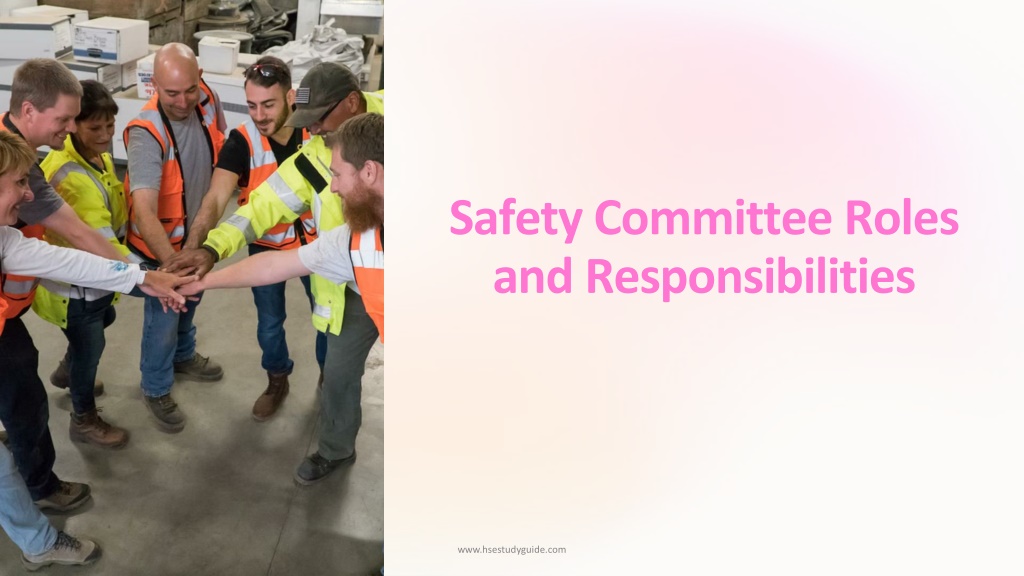Common Roles and Responsibilities of Safety Committees in Organizations
Safety committees in organizations play a crucial role in ensuring the overall safety and well-being of employees, customers, and visitors. Key roles include the chairperson leading meetings, the secretary documenting minutes, members representing departments, and safety coordinator managing policies and training. Committees are responsible for risk assessment, policy development, safety training, incident investigation, promoting safety culture, and continuous improvement initiatives.
Download Presentation

Please find below an Image/Link to download the presentation.
The content on the website is provided AS IS for your information and personal use only. It may not be sold, licensed, or shared on other websites without obtaining consent from the author. Download presentation by click this link. If you encounter any issues during the download, it is possible that the publisher has removed the file from their server.
E N D
Presentation Transcript
Safety Committee Roles and Responsibilities www.hsestudyguide.com
Safety Committee A safety committee typically consists of individuals from various departments or areas within an organization who come together to ensure the overall safety and well-being of employees, customers, and visitors. www.hsestudyguide.com
Here are some common roles and responsibilities of a safety committee: Chairperson: The chairperson is responsible for leading safety committee meetings, setting the agenda, and ensuring that discussions are productive and focused on safety objectives. Secretary: The secretary is responsible for documenting meeting minutes, action items, and any decisions made during safety committee meetings. They may also be responsible for maintaining records related to safety incidents, inspections, and training. Members: Each member of the safety committee represents their respective department or area of the organization. Their role is to actively participate in meetings, provide input on safety policies and procedures, and communicate safety concerns or issues from their department to the committee. Safety Coordinator/Manager: This individual, if present, may serve as a liaison between the safety committee and management. They are responsible for overseeing the implementation of safety policies and procedures, conducting safety training, and ensuring compliance with relevant regulations and standards. www.hsestudyguide.com
Here are some common roles and responsibilities of a safety committee: Risk Assessment and Hazard Identification: The safety committee is responsible for regularly assessing workplace risks and identifying potential hazards. This may involve conducting safety inspections, reviewing incident reports, and soliciting feedback from employees. Safety Policies and Procedures: The committee plays a key role in developing, reviewing, and updating safety policies and procedures to ensure they are comprehensive, up-to-date, and effectively communicated to all employees. Training and Education: Ensuring that employees receive adequate safety training and education is essential for preventing accidents and injuries. The safety committee may organize and coordinate training sessions, workshops, or other educational programs on various safety topics. Incident Investigation: In the event of a safety incident or near miss, the safety committee may be responsible for conducting an investigation to determine the root cause(s) and identify corrective actions to prevent similar incidents in the future. www.hsestudyguide.com
Here are some common roles and responsibilities of a safety committee: Safety Promotion and Awareness: The committee plays a crucial role in promoting a culture of safety within the organization. This may involve organizing safety awareness campaigns, distributing safety-related communications, and recognizing employees for their contributions to safety. Continuous Improvement: The safety committee should continuously monitor and evaluate the effectiveness of safety initiatives and programs. They should identify areas for improvement and implement corrective actions as necessary to enhance overall safety performance. www.hsestudyguide.com
By fulfilling these roles and responsibilities, the safety committee helps to create a safer and healthier work environment for everyone within the organization. www.hsestudyguide.com























